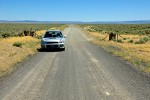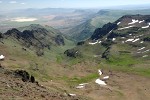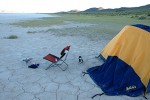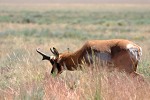- Travel + Photos
- Voyages
- Steens Mountain
Steens Mountain: In Search of Solitude

For a couple of years now, I've been thinking about visiting the Steens Mountain but never got motivated enough to go. Recently, I was in a somewhat antisocial mood and wanted to get away from the people and civilization. That was all the motivation I needed to drive to this remote southeast corner of Oregon in search of some quality time in solitude.
Lone Cowboy
The Steens Mountain is in the remote southeast corner of Oregon, where roads can go straight for miles and miles and miles with nothing interesting in view. The closest city is Burns, with its 3064 inhabitants. The towns of Frenchlen to the north and Fields to the south of the Steens Mountain are nothing more than just a convenience store with gas pumps and a lodge. You so rarely cross anyone on the road that when you do, you are inclined to flash a greeting sign as if you were part of an exclusive society.

It's always an unsettling feeling for me when driving alone on a deserted road in the middle of nowhere, close to sunset and not knowning where I will sleep that night. Which happened on the second and third nights on this trip. The feeling was even a bit creepy on the second day en route to the Alvord Desert. I've had only crossed two other cars since the afternoon. As the sun got lower and lower, the Alvord Desert was still nowhere in sight, but the vultures made their presence known. It crossed my mind that I could become their meal, then quickly I chased that thought.
All this made me feel like a lone cowboy riding in the wild west (except that I had many horses under the hood).
Steens Mountain

The Steens Mountain is a large fault-block mountain with quite interesting landscape. On its west side, the slope raises so gently that you don't know you're on a 9733 ft (2967 m) mountain until you see the 4200 ft (1300 m) drop from the East Rim into the floor of the Alvord Desert to the east. The ancient glaciers have carved into the mountain many U-shaped gorges, in particular the Kiger Gorge and its famous notch resulting from glaciers on both side of the wall joining at that point.
I was hoping to see some wild mustangs and bighorns, but didn't see any. The only wildlife I saw was some fishes in Wildhorse Lake, the birds and some golden eagles that glide the late afternoon updraft off the cliff of the Steens Mountain.
Alvord Desert
The Alvord Desert is a 12 by 7 miles (19 by 11 km) dry lake that sits at approximatively 4500 ft (1370 m) in elevation. The first thing I did when I got there was driving on the desert floor just to find out how it is like. I must say that it is much smoother than driving on the gravel roads leading to it.

The second thing I did was finding a good spot to set camp. There is no campsite at the Alvord Desert, but "primitive" camping is allowed since it is on BLM (Bureau of Land Management) land. There was another group (of motocross riders) camping on the desert, but I camped far enough from them that it felt as if I was alone on the desert. Later, I enjoyed sitting on my camping chair, cooking then eating while watching the light of the sunset.
The third thing I did, after setting camp, was driving around taking pictures of the desert and the Alvord Hot Springs. The hot srpings is actually on private land, but its access is open to the public and there is no use fees. My plans was to take a dip in the hot springs in the evening after dinner, but there were too many people. Even though they were pretty girls (I still wonder where they came from since they were clearly not camping there), I was not in the mood to socialize and prefered to come back early morning to have the place for myself.
The night was much warmer than I expected. In fact, it was the warmest night of the whole trip. The half-moon was high early evening and I was a little disappointed at the (relatively) few stars I could see. But when I got out of my tent around one o'clock, the moon had already set, the sky was invaded with stars and the Milky Way was clearly visible.
Hart Mountain
Hart Mountain National Antelope Refuge was an afterthought on this trip. I have heard several people mentioned it and was in no hurry to get home, so I decided to pay a visit there before heading home.

I was lucky enough to see an antelope from up close. It didn't seem to be bothered by my presence, probably knowing it can't be harmed by human in the refuge. I also saw a group of 5-6 antelopes around Petroglyphs Lake but they were too far away to photograph. However, I was told by the people at the refuge's headquarter that there were less antelopes returning this year.
I enjoyed having lunch at Petroglyphs Lake, on a tip from one of the volunteers at the headquarter. I didn't spend enough time there to find any petroglyphs, but enough to watch the birds and the flora.
The best surprise for me was the landscape when leaving Hart Mountain. Maybe the light of the late afternoon was just right, maybe I came at the right time of the year where the lakes just dried out but the vegetation was still green, or maybe I was just tired of the arid desert landscape. Whatever it was, the view of the Warner Valley from Hart Mountain was stunning.
Back to Civilization
Not being able to camp at Fort Rock State Park as planned (day use only), and arriving too late to a private camping site near by (they close at 6 pm), I decided to set camp somewhere on the Deschutes National Forest land. That night was the coldest night of the whole trip: 9°C (48°F) in my tent at 3 AM and 3°C (38°F) at 5 AM. But it warmed up very quickly when the sun came out; by 7:30 AM, I was standing outside in short and T-shirt in the sun packing my tent.
Not wanting to set fire to the forest, I opted to buy breakfast in town. After 3 days of feeding on instant ramen noodle, nutella on bread, dried mango and the occasional bugs that I accidentally swallowed at dusk, the Egg McMuffin breakfast tasted o soooo good (for the record, it was in Redmond, OR). I was officially back to civilization, but that still didn't make me like the crowd, nor the way people drive. Since I can't completely pass off on civilization, I just have to pick and choose between the good and the bad of our supposedly great civilization.
Practical Details
Dates of the trip: 17-20 July, 2010
The Steens Mountain Back Country Byway (or scenic loop) is usually open from early July until snow falls. Its first half (Frenchlen to the Summit) is passable in passenger car, high clearance 4WD vehicle is recommended for the second half. I didn't try to find out whether the second half is actually passable in a low clearance 4WD. Kiger Gorge, the East Rim Viewpoint, the Summit and Wildhorse Gorge can all be seen in the first half of the loop.
I got to Fish Lake campgound around 5:30 PM and there were still 5-7 campsites available. It might be different on a holiday weekend.
There are a lot of mosquitoes around Burns, Fish Lake and Page Springs campgrounds at the Steens Mountain. (I was told there are more mosquitoes at Page Springs than Fish Lake). So using bugs repellent is highly advised. There is no mosquito on the Alvord Desert!
Fill up your tank whenever you can; gas stations in southeastern Oregon are few and far between. The best towns for gas are Burns and Lakeview. Even though one can get gas in Frenchlen and Fields, they only serve regular and diesel, and only when the store is open.
Links
- http://web.oregon.com/hiking/steens_mountain.cfm
- http://www.summitpost.org/mountain/rock/150771/steens-mountain.html
- http://www.wanderthewest.com/index.php/proximity?id=13347&miles=40
- http://www.blm.gov/or/districts/burns/recreation/index.php
Copyright © 2010, Northwest Summit. All rights reserved.
No part of this page may be reproduced, republished or copied without the express written permission of its author.